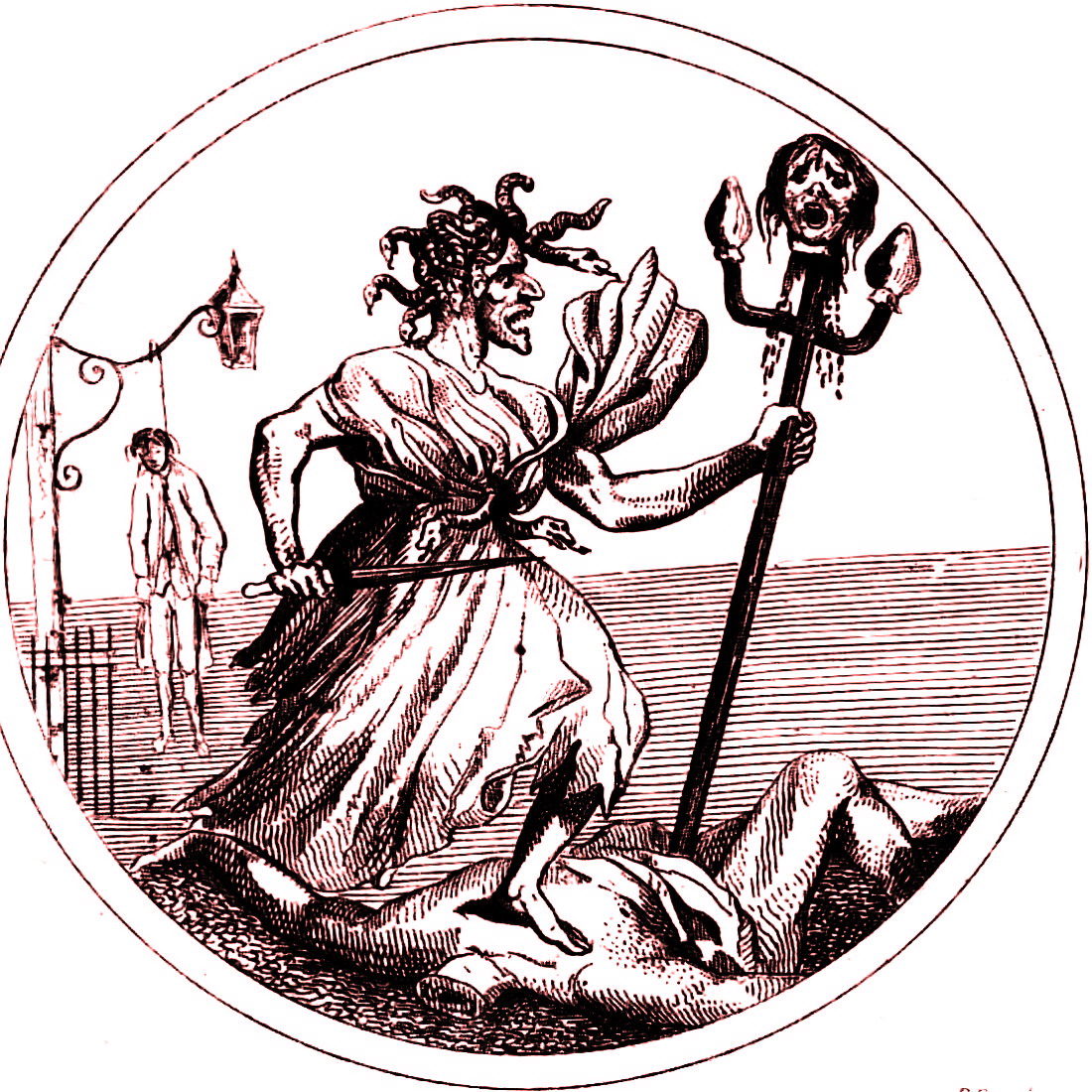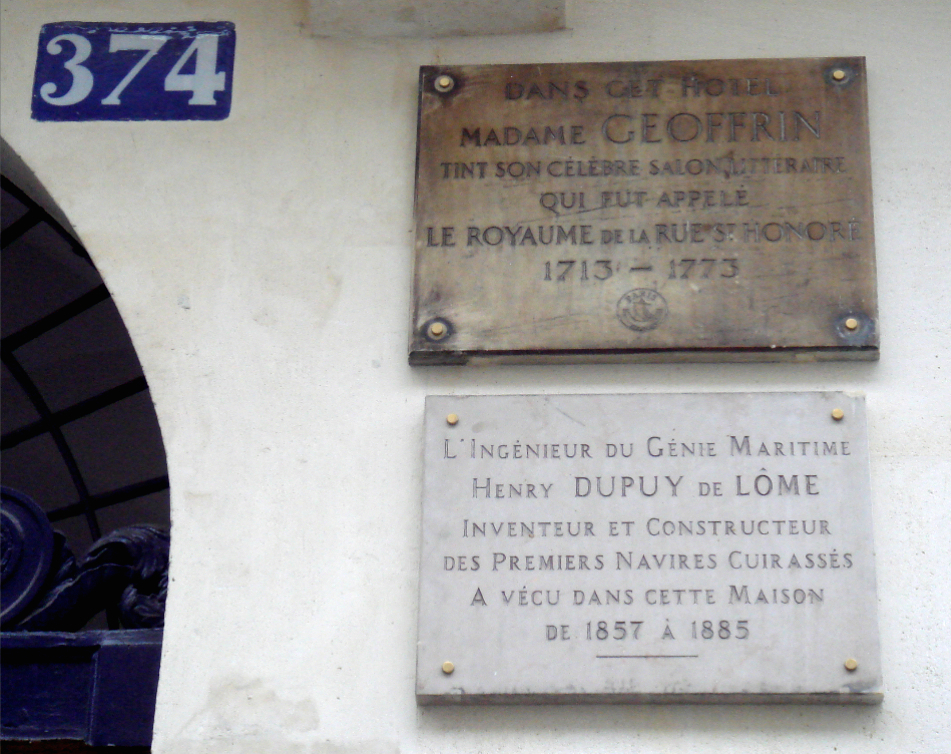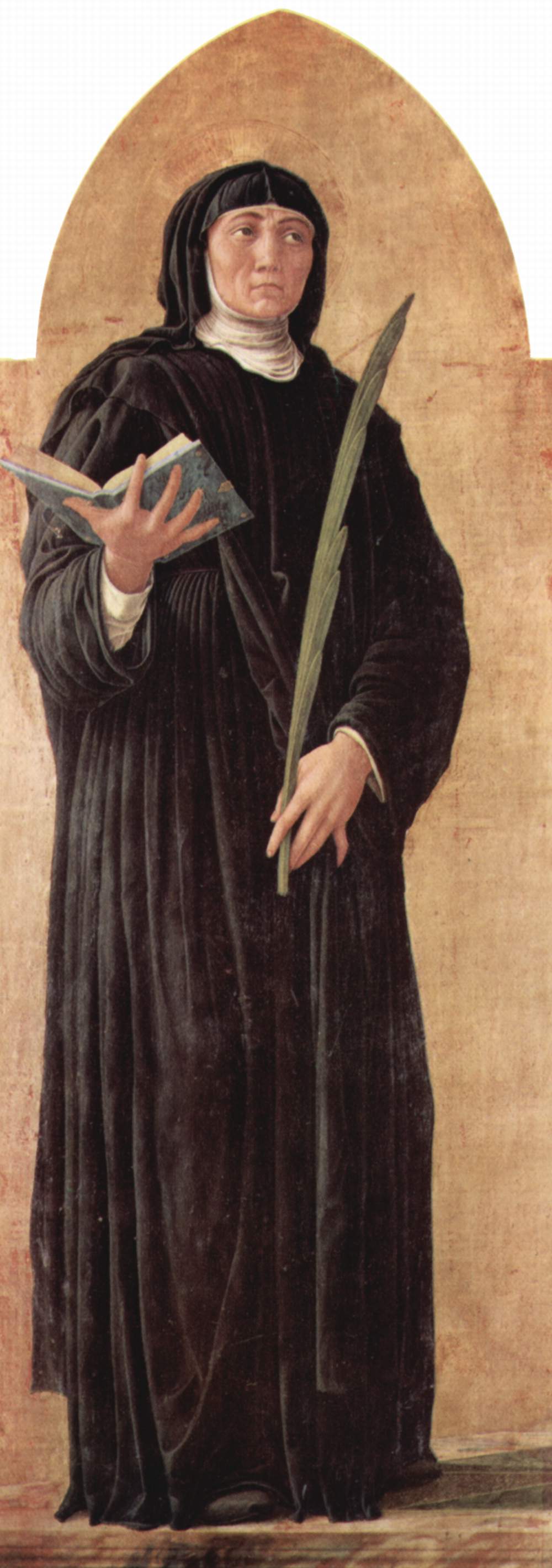|
Marie Marguerite Françoise Hébert
Marie Marguerite Françoise Hébert, née Marie Goupil (1756, Paris – 13 April 1794, Paris), was a figure in the French Revolution who died by guillotine during the Reign of Terror. Biography Marie Goupil was born in Paris to Jacques Goupil, a lingerie merchant who died prematurely, and Louise Morel (who died in 1781). She became a nun in the Convent of the Conception ( on rue Saint-Honoré) in Paris as a "Sister of Providence." but she left the convent after the suppression of monastic vows. Choosing to pursue new ideas, she became a member of the Fraternal Society of Both Sexes, which was an early example of women actively participating in politics. At one of the group's meetings, she met the prominent revolutionary Jacques René Hébert and they married on 7 February 1792. The couple had a daughter Scipion-Virginie Hébert (7 February 1793 – 13 July 1830), but the infant was orphaned when her father was guillotined on 24 March 1794, and her mother Marie was guillotined ... [...More Info...] [...Related Items...] OR: [Wikipedia] [Google] [Baidu] |
Paris
Paris () is the Capital city, capital and List of communes in France with over 20,000 inhabitants, largest city of France. With an estimated population of 2,048,472 residents in January 2025 in an area of more than , Paris is the List of cities in the European Union by population within city limits, fourth-most populous city in the European Union and the List of cities proper by population density, 30th most densely populated city in the world in 2022. Since the 17th century, Paris has been one of the world's major centres of finance, diplomacy, commerce, culture, Fashion capital, fashion, and gastronomy. Because of its leading role in the French art, arts and Science and technology in France, sciences and its early adoption of extensive street lighting, Paris became known as the City of Light in the 19th century. The City of Paris is the centre of the Île-de-France region, or Paris Region, with an official estimated population of 12,271,794 inhabitants in January 2023, or ... [...More Info...] [...Related Items...] OR: [Wikipedia] [Google] [Baidu] |
Errancis Cemetery
Errancis Cemetery or ''Cimetière des Errancis'' is a former cemetery in the 8th arrondissement of Paris and was one of the cemeteries (the others being Madeleine Cemetery, Picpus Cemetery, Chapelle expiatoire and the Cemetery of Saint Margaret) used to dispose of the corpses of guillotine victims during the French Revolution. History and location Errancis Cemetery opened on March 5, 1793, and was closed on April 23, 1797. On the site there are now apartments. The cemetery was located between the current Boulevard de Courcelles, Rue de Rocher, Rue de Monceau and Rue de Miromesnil, at that time a plot running along '' le mur des Fermiers-Généraux''. During the French Revolution The cemetery was used for the bodies of victims of the guillotine after the Madeleine Cemetery was closed. It was used for this purpose between March 25, 1793, until the end of May 1795. The memorial plaque, located on Rue de Monceau between number 97 and the corner with Rue de Rocher, states that 1 ... [...More Info...] [...Related Items...] OR: [Wikipedia] [Google] [Baidu] |
Jacques René Hébert
Jacques or Jacq are believed to originate from the Middle Ages in the historic northwest Brittany region in France, and have since spread around the world over the centuries. To date, there are over one hundred identified noble families related to the surname by the Nobility & Gentry of Great Britain & Ireland. Origins The origin of this surname comes from the Latin ' Iacobus', associated with the biblical patriarch Jacob. Ancient history A French knight returning from the Crusades in the Holy Lands probably adopted the surname from "Saint Jacques" (or "James the Greater"). James the Greater was one of Jesus' Twelve Apostles, and is believed to be the first martyred apostle. Being endowed with this surname was an honor at the time and it is likely that the Church allowed it because of acts during the Crusades. Indeed, at this time, the use of biblical, Christian, or Hebrew names and surnames became very popular, and entered the European lexicon. Robert J., a Knight Crusader ... [...More Info...] [...Related Items...] OR: [Wikipedia] [Google] [Baidu] |
Guillotine
A guillotine ( ) is an apparatus designed for effectively carrying out executions by Decapitation, beheading. The device consists of a tall, upright frame with a weighted and angled blade suspended at the top. The condemned person is secured with a pillory at the bottom of the frame, holding the position of the neck directly below the blade. The blade is then released, swiftly and forcefully decapitating the victim with a single, clean pass; the head falls into a basket or other receptacle below. The guillotine is best known for its use in France, particularly during the French Revolution, where the revolution's supporters celebrated it as the people's avenger and the revolution's opponents vilified it as the pre-eminent symbol of the violence of the Reign of Terror. While the name "guillotine" dates from this period, similar devices had been in use elsewhere in Europe over several centuries. Use of an oblique blade and the pillory-like restraint device set this type of gui ... [...More Info...] [...Related Items...] OR: [Wikipedia] [Google] [Baidu] |
Reign Of Terror
The Reign of Terror (French: ''La Terreur'', literally "The Terror") was a period of the French Revolution when, following the creation of the French First Republic, First Republic, a series of massacres and Capital punishment in France, numerous public executions took place in response to the Federalist revolts, revolutionary fervour, Anti-clericalism, anticlerical sentiment, and accusations of treason by the Committee of Public Safety. While terror was never formally instituted as a legal policy by the Convention, it was more often employed as a concept. Historians disagree when exactly "the Terror" began. Some consider it to have begun in 1793, often giving the date as 5 September or 10 March, when the Revolutionary Tribunal came into existence. Others cite the earlier September Massacres in 1792, or even July 1789 when the first killing of the revolution occurred. Will Durant stated that "strictly, it should be dated from the Law of Suspects, September 17, 1793, to the e ... [...More Info...] [...Related Items...] OR: [Wikipedia] [Google] [Baidu] |
Rue Saint-Honoré
The Rue Saint-Honoré () is a street in the 1st arrondissement of Paris, France. It is named after the collegial , situated in ancient times within the cloisters of Saint-Honoré. The street, on which are located a number of museums and upscale boutiques, is near the Tuileries Gardens and the Saint-Honoré market. Like many streets in the heart of Paris, the Rue Saint-Honoré, as it is now known, was laid out as early as the Middle Ages or before. The street, at one time, continued beyond the former city walls into what was the ''faubourg'' (from Latin ''foris burgem'', an area "outside the city"). This continuation was eventually named the Rue du Faubourg Saint-Honoré. History The Rue Saint-Honoré has been given the following names in its long history: *The section between the Rue de la Lingerie and the Rue de la Tonnellerie was named the Rue de la Chausseterie from 1300 to the 17th century. *The section between the now extinct Rue Tirechappe and the Rue de l'Arbre Sec was ... [...More Info...] [...Related Items...] OR: [Wikipedia] [Google] [Baidu] |
Fraternal Society Of Patriots Of Both Sexes
The Fraternal Society of Patriots of Both Sexes, Defenders of the Constitution () was a French revolutionary organization notable in the history of feminism as an early example of active participation of women in politics. History The Fraternal Society was founded in October 1790 by Claude Dansard, ''un maître de pension,'' or school master.Aulard and Miall 1910, p. 234 This organization's goal was to provide a civic education that would lead to revolutionary acts becoming a daily occurrence. An original characteristic of this group was the fact that they were widely inclusive to women.Godineau 1998p. 105/ref>Janet K. Boles, Diane Long Hoeveler, ''Historical Dictionary of Feminism'', 2004, , pp.301–302 Originally, the organization's meeting place was an old library room of the disused Dominican (called "Jacobins" in France) convent on Rue Saint-Honoré, the one which hosted the revolutionary Jacobin Club.John Goldworth Alger, ''Glimpses of the French Revolution: Myths, Idea ... [...More Info...] [...Related Items...] OR: [Wikipedia] [Google] [Baidu] |
Lucile Desmoulins
Anne-Lucile-Philippe Desmoulins, born Laridon-Duplessis (18 January 1770 in Paris – 13 April 1794) was a French revolutionary, diarist, and author during the French Revolution. She was married to the revolutionary Camille Desmoulins. She was executed eight days after Camille Desmoulins and Georges Danton, accused of conspiring to free her husband and involvement in counter-revolutionary activities. Life and Writings Lucile Duplessis Desmoulins was born in Paris in 1770, the daughter of Claude-Etienne Laridon-Duplessis, an official of the French Treasury, and Anne-Françoise-Marc Bosdeveix (who went by "Annette"). She had one sister, Adèle Duplessis, born in 1774, who some sources have claimed was briefly engaged to Maximilien Robespierre. Lucile spent her childhood and young adulthood in Paris and on her family's farm in Bourg-la-Reine. She kept several diaries, beginning in 1788. She also authored numerous poems, prose works, and short stories, none of which were publis ... [...More Info...] [...Related Items...] OR: [Wikipedia] [Google] [Baidu] |
1756 Births
Events January–March * January 16 – The Anglo-Prussian alliance (1756)#Treaty, Treaty of Westminster is signed between Kingdom of Great Britain, Great Britain and Prussia, guaranteeing the neutrality of the Electorate of Hanover, controlled by King George II of Great Britain. * January 27 – Wolfgang Amadeus Mozart is born in Salzburg, Austria, to Anna Maria Mozart, Anna Maria and Leopold Mozart. * February 7 – Guaraní War: The leader of the Guaraní people, Guaraní rebels, Sepé Tiaraju, is killed in a skirmish with Spanish and Portuguese troops. * February 10 – The massacre of the Guaraní people, Guaraní rebels in the Jesuit reduction of Caaibaté takes place in Brazil after their leader, Noicola Neenguiru, defies an ultimatum to surrender by 2:00 in the afternoon. On February 7, Neenguiru's predecessor Sepé Tiaraju has been killed in a brief skirmish. As two o'clock arrives, a combined force of Spanish and Portuguese troops makes an assault on the first ... [...More Info...] [...Related Items...] OR: [Wikipedia] [Google] [Baidu] |
1794 Deaths
Events January–March * January 1 – The Stibo Group is founded by Niels Lund as a printing company in Aarhus (Denmark). * January 13 – The U.S. Congress enacts a law providing for, effective May 1, 1795, a United States flag of 15 stars and 15 stripes, in recognition of the recent admission of Vermont and Kentucky as the 14th and 15th states. A subsequent act restores the number of stripes to 13, but provides for additional stars upon the admission of each additional state. * January 21 – King George III of Great Britain delivers the speech opening Parliament and recommends a continuation of Britain's war with France. * February 4 – French Revolution: The National Convention of the French First Republic abolishes slavery. * February 8 – Wreck of the Ten Sail on Grand Cayman. * February 11 – The first session of the United States Senate is open to the public. * March 4 – The Eleventh Amendment to the United States Constit ... [...More Info...] [...Related Items...] OR: [Wikipedia] [Google] [Baidu] |
Nuns From Paris
A nun is a woman who vows to dedicate her life to religious service and contemplation, typically living under vows of poverty, chastity, and obedience in the enclosure of a monastery or convent.''The Oxford English Dictionary'', vol. X, page 599. The term is often used interchangeably with religious sisters who do take simple vows but live an active vocation of prayer and charitable work. In Christianity, nuns are found in the Catholic, Oriental Orthodox, Eastern Orthodox, Lutheran, and Anglican and some Presbyterian traditions, as well as other Christian denominations. In the Buddhist tradition, female monastics are known as Bhikkhuni, and take several additional vows compared to male monastics (bhikkhus). Nuns are most common in Mahayana Buddhism, but have more recently become more prevalent in other traditions. Christianity Catholicism In the Catholic tradition, there are many religious institutes of nuns and sisters (the female equivalent of male monks or friars ... [...More Info...] [...Related Items...] OR: [Wikipedia] [Google] [Baidu] |








